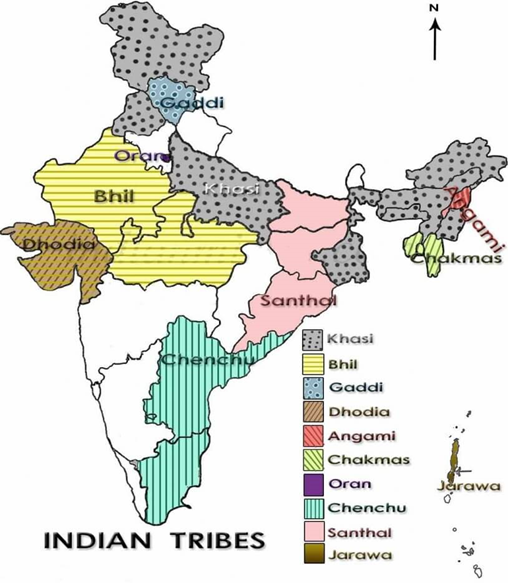“India is a melting-pot of cultures and the Tribal communities are part of India’s diverse cultural treasury. “
Article 342 of the Constitution says that-‘The Scheduled Tribes are the tribes or tribal communities or part of or groups within these tribes and tribal communities which have been declared as such by the President through a public notification’. Among the tribal groups, several have adapted to modern life but there are tribal groups who are more vulnerable. The Dhebar Commission (1973) created a separate category “Primitive Tribal Groups (PTGs)”. Their vulnerability is not because of their primitive existence and non-inclusion in modern practises of societies, but due to their significant culture and diverse livelihood practises. They are important for India’s diversity which is our strength and world know us for our ‘Unity in Diversity’.
|
Andhra Pradesh |
Andh And Sadhu Andh, Bhil, Bhaghata, Dhulia,rona, Kolam, Gond, Thoti, Goundu, Kammara, Savaras, Dabba Yerukula, Sugalis, Nakkala, Pardhan, Gadabas, Chenchus A.k.a Chenchawar, Kattunayakan, Jatapus, Manna Dhora |
|
Arunachal Pradesh |
Singpho, Monpa, Abor, Sherdukpen, Galo, Apatanis |
|
Assam |
Khasis, Chakma, Dimasa, Gangte, Garos, Hajong, Chutiya |
|
Bihar |
Gond, Birjia, Asur, Savar, Parhaiya, Chero, Birhor, Santhals, Baiga |
|
Chhattisgarh |
Nagasia, Biar, Khond, Agariya, Bhattra, Mawasi, Bhaina, |
|
Goa |
Varli, Dubia, Siddi, Dhodia, Naikda |
|
Gujarat |
Patelia, Bhil, Dhodia, Bamcha, Barda, Paradhi, Charan, Gamta |
|
Himachal Pradesh |
Swangal, Gujjars, Lahaulas, Khas, Pangwala, Lamba, Gaddis |
|
Jammu and Kashmir |
Balti, Garra, Sippi, Bakarwal, Mon, Gaddi, Purigpa, Beda |
|
Jharkhand |
Gonds, Birhors, Savar, Mundas, Santhals, Khaira, Bhumji |
|
Karnataka |
Gond, Patelia, Barda, Yerava, Bhil, Koraga, Adiyan, Iruliga, |
|
Kerala |
Malai, Aarayan, Arandan, Uralis, Kurumbas, Arandan, Eranvallan |
|
Madhya Pradesh |
Kharia, Bhils, Murias, Birhors, Baigas, Katkari, Kol, Bharia, Khond, Gonds, |
|
Maharashtra |
Warlis, Khond, Bhaina, Katkari, Bhunjia, Rathawa, Dhodia. |
|
Manipur |
Thadou, Aimol, Maram, Paite, Chiru, Purum, Kuki, Monsang, Angami |
|
Meghalaya |
Pawai, Chakma, Raba, Hajong, Lakher, Garos, Jaintias Khasis |
|
Mizoram |
Dimasa, Raba, Chakma, Lakher, Khasi, Synteng, Kuki, Pawai. |
|
Nagaland |
Nagas, Angami, Sema, Garo, Kuki, Kachari, Mikir |
|
Odisha |
Gadaba, Ghara, Kharia, Khond, Matya, Oraons, Rajuar, Santhals. |
|
Rajasthan |
Bhils, Damaria, Dhanka, Meenas(Minas), Patelia, Sahariya. |
|
Sikkim |
Bhutia, Khas, Lepchas. |
|
Tamil Nadu |
Adiyan, Aranadan, Eravallan, Irular, Kadar, Kanikar, Kotas, Todas. |
|
Telangana |
Chenchus. |
|
Tripura |
Bhil, Bhutia, Chaimal, Chakma, Halam, Khasia, Lushai, Mizel, Namte. |
|
Uttarakhand |
Bhotias, Buksa, Jannsari, Khas, Raji, Tharu. |
|
Uttar Pradesh |
Bhotia, Buksa, Jaunsari, Kol, Raji, Tharu. |
|
West Bengal |
Asur, Khond, Hajong, Ho, Parhaiya, Rabha, Santhals, Savar. |
|
Andaman and Nicobar |
Oraons, Onges, Sentinelese, Shompens. |
|
Little Andaman |
Jarawa |
|
North-East |
Abhors, Chang, Galaong, Mishimi, Singpho, Wancho. |
PVTGs (Particularly Vulnerable Tribal Groups) are more vulnerable among the tribal groups. Due to this factor, more developed and assertive tribal groups take a major chunk of the tribal development funds, because of which PVTGs need more funds directed for their development.
|
Characteristics of PVTGs:
|
 Significant Tribal Cultures
Significant Tribal Cultures
Amongst the huge number of tribes existing across the country, we have profiled the 30 most interesting and comparatively popular indigenous tribes in India and their culture. The culture and way of living of tribal communities depends upon the geographic region of India. Hence, we will discuss them according to the region they belong to.
Tribes of North India
Indian tribal dances are simple, and they are performed to get pleasure from them. Dancing is a part of daily life and religious rituals. Traditional dancing is organised on every time, i.e. the births of children, festivals, marriage opportunities and the arrival of seasons. Indian folk and tribal dances are dance with minimal steps or movements. These folk dances of India are full of vibrancy, enthusiasm and energy.
With the advent of industrialisation in India and the discovery of mineral and other resources in tribal inhabited areas, the tribal pockets were thrown open to outsiders and state control replaced tribal control.
As per Census 2011, literacy rate of Scheduled Tribes (STs) was 59%
Because of economic backwardness and insecure livelihood, the tribals face health problems, such as prevalence of disease, like malaria, cholera, tuberculosis, diarrhoea and jaundice, problems associated with malnutrition like iron deficiency and anaemia, high infant mortality rates, low levels of life expectancy, etc.
The tribes in India are under the impact of ‘mobility and change’. There are numerous examples of tribes transforming themselves into the larger entity of the caste system; others have become Christian or Muslim. They also join the ranks of peasantry and in modern times they become wage-labourers in industries, plantations and mining. Thus, in the concept of tribe, the aspects of mobility and change should not be overlooked to conserve their culture.
Verifying, please be patient.